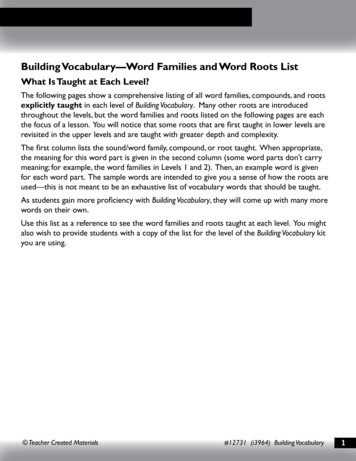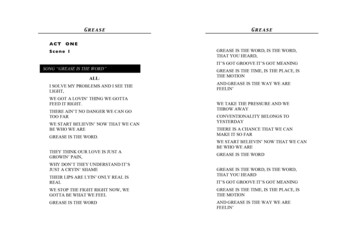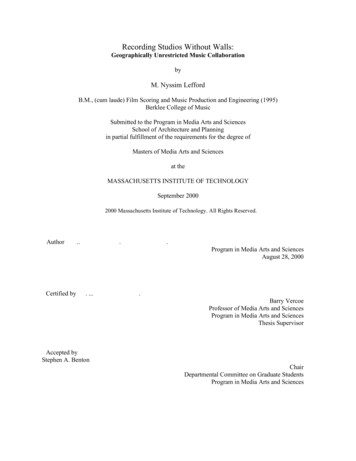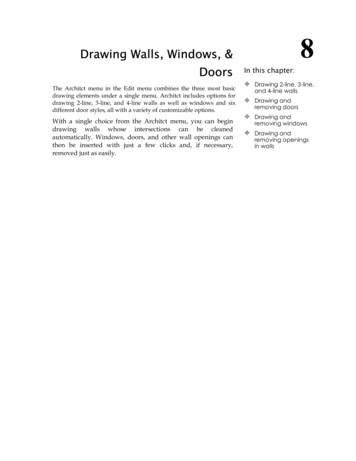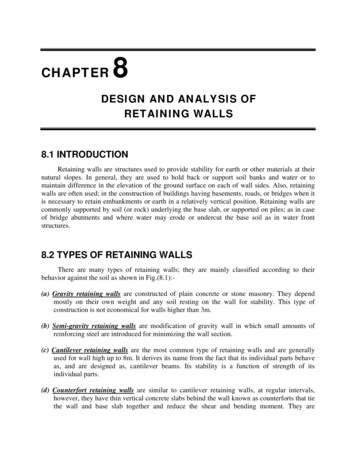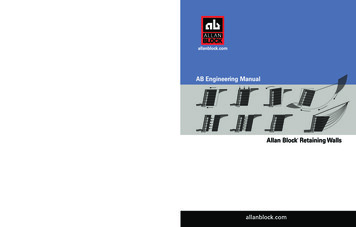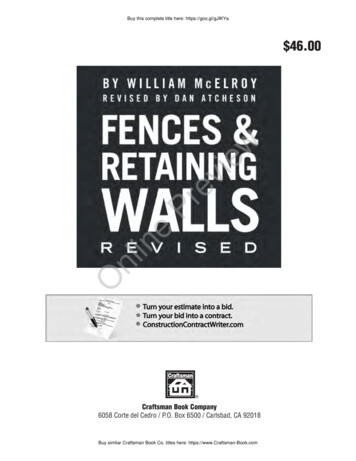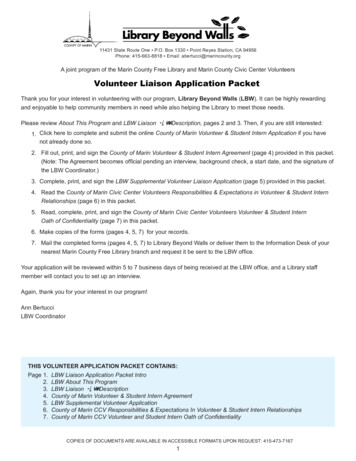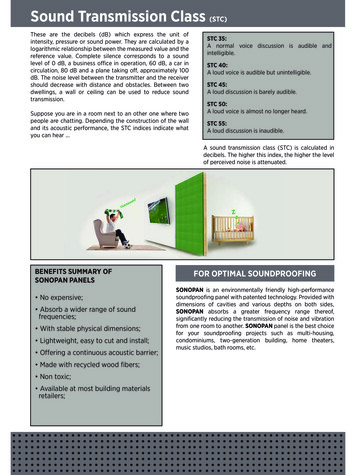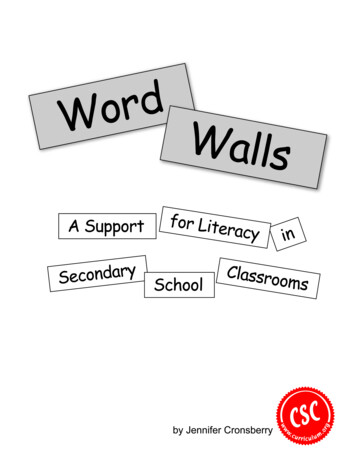
Transcription
AcknowledgementsThis resource has been made possible through the generous donations of private individuals,foundations and corporations who support The Curriculum Foundation, the charitable arm ofCurriculum Services Canada. For more details please see www.curricululm.org and click on“Grants for Teachers.”
Word Walls: A Support for Literacy in Secondary SchoolClassroomsIntroductionEach year students must learn and use thousands of new words in their various subjectdiscipline studies. They are required to perform complex tasks using new vocabulary. The useof a word wall in a classroom can be a highly effective teaching strategy to improve literacyskills. Word wall activities encourage active student participation. Gestures, such as pointing tokey words during a lesson, offer visual reinforcement which can be very helpful for students.Word wall activities engage students while they learn key vocabulary, whether it be learning toexplain a word, to compare it to other key concepts, or to spell it.A word wall is a group of words that are displayed on a wall, bulletin board, chalkboard, orwhiteboard in a classroom. The words are printed in a large font so that they are easily visiblefrom all student seating areas. These words are referred to continually throughout a unit or termby the teacher and students during a variety of activities.Word walls: provide an approach to meaningful teaching of vocabularywith an emphasis on student engagement and higher levelthinking skills; build vocabulary, thereby improving reading comprehensionand writing style; reinforce understanding of subject-specific terminology with afocus on students internalizing key concepts; help students improve spelling and awareness of spellingpatterns; provide visual cues for students; encourage increased student independence when readingand writing. Jennifer Cronsberry, 2004page 3
Curriculum ConnectionsWord wall activities can be used to improve literacy in all curriculum areas by helping studentsbuild vocabulary, improve spelling in written work, and explain ideas through oralcommunication.ExamplesIn English curriculumstudents:In Science curriculumstudents:In Geography curriculumstudents: use specialized literaryterms in analysis andexplanations of readingmaterials; communicate scientificideas, procedures,results, and conclusionsusing appropriatelanguage and formats; demonstrateunderstanding of termsand concepts; comprehend newvocabulary encounteredin reading materials; increase effectiveness inwriting style throughincreased awareness ofdiction and a broadervocabulary.In Arts curriculum students: use appropriatelylanguage specific to eachof the arts when doingcritical analysis; describe dance works,using the language ofdance criticism. Jennifer Cronsberry, 2004 demonstrate a knowledgeof geographic terms. recognize and describethe major components ofthe universe usingscientific terminology andunits.In Business curriculumstudents:In Mathematics curriculumstudents: define key informationtechnology terms; communicate the findingsof investigations, usingappropriate language andmathematical forms. use current informationtechnology terminologyappropriately.page 4
Basic Organizational PrinciplesHow Many Words and How Often?Vocabulary instruction using a word wall focuses on a small number of targeted vocabularywords that are key to student success in a unit and the course overall. Teachers decide whetherto introduce new words weekly or to begin the unit by introducing all new vocabulary as anoverview. The approach would depend on the focus of the word wall and the unit with which itcoincides.The words selected for a word wall are addressed continually, using a wide variety of engagingactivities.Creating the Word WallIn secondary schools, where different teachers, different courses, and different grade levelsoften share the same classroom, finding sufficient space for a word wall may prove to be achallenge. In the Resources section of this document there are references to sources of ideasfrom teachers who have found ways to display word walls in limited space. When space islimited, the word wall may need to be changed for each unit rather than keeping key terms up allyear. Ideally, key terms from a previous unit could be moved to another space in the room toremain available for visual reference throughout the course.Ideas Mount the words on construction paper or card stock andlaminate them. Colour code the words, either using coloured markers forlettering or coloured paper for mounting. Colour coding can beused in numerous ways, e.g., same colours can be used tohighlight homonyms, synonyms, parts of speech, frequentlymisspelled words, or categories. Use a wall area that is visible to all students. If the word wall isto be used effectively, students need to be able to glance at theword wall from their desks while they are working. Mount words on the wall in alphabetical order. Usingalphabetical order makes it easier for students to skim the listand find words. Make access to the words easy, e.g., use tape or tacks tomount the words so students can move individual words. Jennifer Cronsberry, 2004page 5
Types of WordsAll courses have subject-specific terminology that can be used for a word wall.SuggestionsGeographyFrenchMathematics terms and conceptsassociated withgeographical regions verbs conjugated with“etre” for passé compose vocabulary for mathconcepts and termscourse topics, e.g.,integers, polynomials,equations, analyticgeometry, measurement,coefficient, slope vocabulary for forms andcharacteristics of systems,e.g., social services,transportation, resourcemanagement, politicalstructures, energynetworks reflexive verbs unit vocabularyScienceArtsEnglish terminology to describemajor concepts elements common to allarts, e.g., space, time,form, contrast, unity,variety, movement,balance literary terms or mediaterms, e.g., cameratechniques biological reproductionprocesses, e.g., mitosis,prophase, metaphase,anaphase and telophase types of asexualreproduction in plantspecies historical periods withstylistic links in the arts,e.g., baroque, preRaphaelite terms used inphotography, sculpture,etc. theme words or transitionwords graphic text features synonyms or homonyms mood/atmosphere words vivid verbs prefixes, suffixes, roots easily confused words,e.g., accept/except parts of speech commonly misspelledwords Jennifer Cronsberry, 2004page 6
Classroom Activities Using Word Walls There are many creative ways to use word walls to engage students in learning. Theactivities may be full lessons, or brief exercises that encourage students to refer to theword wall and review key terms. Shorter activities encourage students to ‘play with’language and can be beneficial for reinforcement of basic skills. Where possible, students should interact with the word wall words whether it be to affix aprefix, or a plural ‘s,’ or to move words so they are intrinsically engaged by the active,creative, and participatory nature of word wall activities. Some classroom activities suggest the use of word cards. These activities require at leastone set of the words on cards such as recipe cards. The words could be generated froma computer and glued to recipe cards when multiple sets are needed. Students should maintain a personal word wall. To make the word wall list stand out,provide an organizational handout that students glue to three-holed construction paper.The construction paper fits into a binder, but sticks out a little more than regular binderpaper, thus making the word wall list easily accessible. The suggested activities are organized as whole class, small groups/partners, orindividual activities. Unless specifically indicated, the activities are done with all the wordsposted on the word wall. Some of the activities could be completed with just the newword(s) introduced on a given day. The word wall activities are suggestions only and can be adapted or modified for usewithin different grade levels and subject disciplines. In presenting word wall activities, teachers must be sensitive to students who may beuncomfortable with completing a task in front of their peers, e.g., spelling exercises aresuggested as individual or partner activities.Whole Class ActivitiesMystery WordIntroduce a new word by writing the letters in a scrambled order. To assist students inunscrambling the word, give clues, either about the word’s meaning or about how it is spelled.Students apply their knowledge of spelling patterns, as well as activate their prior knowledge,depending on the clues given.Visiting WordAfter students have worked on a word wall for a substantial period of time, add a “visiting”word. This encourages students to do a review of the word wall as they hunt for the newword. Present the visiting word as the new word for the day. Jennifer Cronsberry, 2004page 7
Missing WordTake one of the words off the word wall and rearrange the remaining words. Students scanthe word wall and figure out which word is missing. Give clues to help to determine themissing word.Quick DefinitionsProvide a definition (orally and/or written on the board) of one of the word wall words.Students choose and write the word to match the definition. Repeat the process encouragingstudents to review all the words as they select the answer.Looking at SpellingStudents use masking tape to ‘underline’ the part of the word that is typically difficult to spell(e.g., because it is an exception to a rule, a homonym, hard to hear phonetically).Using coloured strips of masking tape, students underline common spelling patterns in thewords such as ‘i’ before ‘e,’ double consonants, or ‘qu.’Small Group ActivitiesWord PicturesWorking in teams, students select one of the words from the word wall and illustrate it on theboard or on chart paper. The opposing team gets a point for a correct guess and illustratesanother word.Word RelationshipsEach student shares the word on their word card with a partner, and together, they decide ona way that their two words are related or have something in common. A time limit could beimposed after which students rotate to a new partner and repeat the process. After doing thisa few times, the pair could join with another pair, and see if they can find a relationshipbetween the four words. Discussing similarities and differences helps students to master newvocabulary meanings.Word Cards Partner GamePairs of students take turns choosing a word card and offering a definition for the word. Thepartner guesses and spells the word.Parts of SpeechEach small group is given a part of speech and must decide which words on the word wall fallinto the category. If more than one group is looking for the same part of speech, theycompare lists and discuss any discrepancies.Small cards can be affixed adjacent to the words on the word wall to identify the part ofspeech for each word.DramaStudents choose a word from the word wall and improvise a situation that portrays the word.Peers guess the word. Jennifer Cronsberry, 2004page 8
PluralsSmall groups are assigned a group of words to pluralize. Students identify the nouns andtape the plural ending of the word on the word wall. Discuss each group’s work as a class.Word AdEach group chooses a word, and brainstorms all the possible uses of the word. They create aradio or television ad to ‘sell’ one of the words from the word wall and present it to the class.As a variation, students think of a product for which they create a radio advertisement, usingas many words as possible from the word wall. The group avoids making direct reference tothe product and asks the class to guess what it is that the ad is trying to sell.CategoriesStudents create categories and group the words from the word wall to fit those categories.Set the number of words that are allowed in a “miscellaneous” category and create amaximum and minimum number of categories that can be used. This activity could be doneindividually first; then students share and compare their categories with a partner. They sharetheir groups of words with the class who guess the principle behind the sorting.Musical WordsIn groups of five or six, with each group member having one word card, students circulate thecards within their groups, while music is playing. When the music stops, the group memberstake turns giving the meaning of the word they have. Group members can challenge thecorrectness of the definition offered by their peer. If a group member cannot provide adefinition, the group members discuss the meaning, asking the teacher for assistance,if necessary.Prefixes and SuffixesEach small group is given a set of the suffix and prefix cards and decides to which words onthe word wall they can add them.As a variation, assign each group a set of words from the word wall for which they mustdecide the appropriate suffixes and prefixes.ContextualizationStudents write about a situation in which a word wall word would be commonly used. Thestudent reads the situation to the class, who then guess the relevant word.As a variation, students portray multiple contextual situations, if applicable, e.g., brackets aresomething that could be spoken about in both writing and construction contexts.Word Origins and Root WordsEach group finds the word origin and root words of a set of word wall words and presents itsfindings to the class.As a variation, groups give the origin of a word and the class guesses the correspondingword wall word. Jennifer Cronsberry, 2004page 9
Names for Musical GroupsStudents brainstorm creative names used by musical groups from both the past and present.After looking at the unique and varied nature of the names, students use one to three wordsfrom the word wall to create a name for a musical group.As an extension, students could write a description of the fictitious group and its style ofmusic.Individual ActivitiesDefinition BingoStudents fill in a bingo-type grid with word wall words. As definitions are read out, studentscross out the corresponding word on their grid. The first person to get a complete line ofwords wins.As a variation: give synonyms or antonyms for appropriate word wall words.Reading BingoStudents fill in a bingo card with new words for a unit. As students complete the unit’sreading, they fill in the page numbers where the unit’s words appear. Acknowledge the firstperson who gets a straight line completed, then assign completion of the entire grid foreveryone in the class.As a variation: Students skim text to find words they have listed on their card.Word of the DayChoose a “Word of the Day.” Encourage students to use the “Word of the Day” meaningfullyduring the class and highlight appropriate use. Add the word to the word wall.Words in WritingEncourage students to use the word wall words in their daily classroom writing. When work iscollected or read in class, highlight the words from the word wall that are used appropriately.Memory AssociationEncourage students to make connections and increase comprehension by selecting a wordwall word that connects to a positive personal memory. Students explain the connection inwriting and share their writing with a partner. Volunteers read their writing aloud to the class.Maximum Words in a StoryStudents write a story involving as many words from the word wall as possible within a giventime frame. Students underline all the word wall words they used and share their stories insmall groups. Each group decides which to read aloud, e.g., the story with the most words orthe most creative story. Jennifer Cronsberry, 2004page 10
Unfolding Five Words in a StoryStudents are given a word wall word every two-minutes for ten minutes (five words in total) toincorporate into a story they are writing on a topic of their choice. When a new word is given,students work that word into their story immediately. Encourage students to writecontinuously and quickly during the ten minutes. Students share their stories in small groupsand each group chooses one story to be read aloud to the class.Words within WordsStudents make a list of as many words as possible by reorganizing some of the letters of aword wall word. Students could write the word on a piece of paper and then cut the lettersapart so that they can move them around and try different combinations.Note: Limits can be set such as that the words must have at least three letters and names donot count.PoetryStudents write a poem related to the topic under study using as many words as possible fromthe word wall. As a variation, students choose just one word from the word wall and write apoem about that word. Students share their poetry.Making ConnectionsStudents give an example of someone from history or the present for each of the traits on thecharacter traits word wall. For a shorter version, students choose ten of the traits for whichthey could give one example.Note: This activity could be adapted to suit other word wall topics.Word ConnotationStudents indicate words with positive or negative connotations from their personal word walllist, using a set of plus ( ) and minus (–) cards. Student volunteers indicate which words havepositive connotation and which words have negative connotation by placing the appropriatecard beside the word wall word.Word SearchStudents use the words from the word wall to create a word search puzzle. Studentsexchange word searches with a partner and find the word wall words.Concept LadderStudents place a word wall word at either the top or the bottom of a ladder image. In eachsuccessive part of the ladder, students fill in information about a different aspect of the word,e.g., what is it like, what is it opposite of, where is it found, how is it used.Concept MapStudents create a concept map for words that define complex concepts. They place the wordin a circle or box on the centre of a page and then draw other circles/boxes branching off thecentre to contain subtopics which can then be further broken down. Jennifer Cronsberry, 2004page 11
Media Re-namingAsk students to re-name a television show or movie using at least one of the appropriateword wall words. Students write the new name on a piece of paper, along with the originalname. Use the papers periodically at the end of class by reading out the new title and askingstudents to guess the original name of the show or movie.RankingsStudents individually list the word wall words, in writing, from most difficult to easiest for themto understand or to spell. If this activity is done at the beginning, middle, and end of a unit,students can note how their rankings have changed.Visual RepresentationStudents choose one word from the word wall to convey its meaning visually. Encouragestudents to not just add illustrations around the word, but to use the letters of the word toconvey meaning appropriately. Post the visual representations around the room and/or theword wall.Rhyme TimeStudents select three to five word wall words with which they can rhyme words. Students listas many rhymes for each word as they can in a given time limit.Metaphors and SimilesStudents practise their abstract thinking skills by choosing five words from the word wall andcreating either a simile or metaphor for each of the words. Students can share their similesand metaphors with others in the class.As an extension, each student chooses one simile or metaphor and writes the comparison onconstruction paper, which is displayed around the classroom. The teacher reads a fewcomparisons each day to reinforce the concept of similes and metaphors.Links to AssessmentAssess student learning through their use of the targeted vocabulary in the larger scope of theirclassroom activities and assessments.Depending on how the words are introduced – whether daily, at the beginning of the week, or atthe beginning of a unit – diagnostic assessment should be brief. Vocabulary assessment couldalso be incorporated into larger diagnostic assessments done for a unit.If students already have some familiarity with the words, the activities that focus on higher-levelthinking skills and extending meaning are suitable. If students have little initial understanding ofa group of words, start with something like a concept map or concept ladder to scaffoldmeaning.Student understanding of the words from the word wall should not be assessed through isolatedvocabulary tests that assess only rote memorization of words rather than genuineunderstanding of their meaning. Jennifer Cronsberry, 2004page 12
An observation checklist could be created to assess student mastery of the word wall words:Volunteers accurate answers in whole class word wall activitiesCompletes word wall activities with easeUses word wall vocabulary appropriately in class and peer discussionsDemonstrates use of words in a variety of contexts, during independent workUses words in class work appropriatelySpells word wall words correctly in written workGlances to the word wall during classRefers to personal word wall listStudents should be assessed for their increased knowledge of and skills with the word wallwords as part of larger performance tasks at the end of a unit/study.Examples Assess students’ ability to spell the word wall vocabulary accurately, in completing amajor assignment. Assess students’ increased vocabulary by looking at their ability to use word wall wordseffectively in a writing piece at the end of a unit. Assess students’ understanding of key concepts inherent in the words by their ability toanswer terminology-based questions on a test. Jennifer Cronsberry, 2004page 13
ResourcesAllen, Janet. Words, Words, Words. Portland: Stenhouse Publishers, 1999.1-57110-085-7Beers, Kylene. When Kids Can’t Read: What Teachers Can Do. Portsmouth: Heinemann, 2003.0-86709-519-9-90000Callella, Trisha. Making Your Word Wall More Interactive. Huntington Beach: Creative TeachingPress, 2001. 1-57471-773-1Cunningham, Patricia C. and Richard L. Allington. Classrooms That Work: They Can All Readand Write. Boston: Allyn and Bacon, 1994. 0-205-35541-2Interactive Word ll062599.htmlOntario Ministry of Education. Think Literacy: Cross Curricular Approaches Grade 7-12,2003. Ontario: Queen’s Printer For Ontario, 2003. 0-7794-5426-XPeel District School Board. Reaching Higher: Supporting student achievement in literacy.Ontario: 2000.Word wall/index.htmWorking with Wordshttp://www.wfu.edu/ cunningh/fourblocks/block4.html Jennifer Cronsberry, 2004page 14
In secondary schools, where different teachers, different courses, and different grade levels often share the same classroom, finding sufficient space for a word wall may prove to be a challenge. In the Resources section


